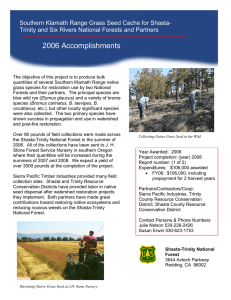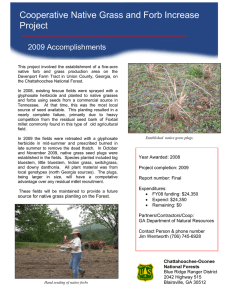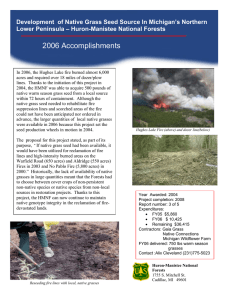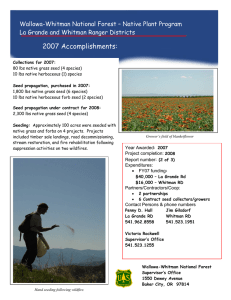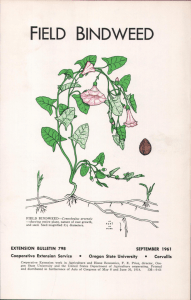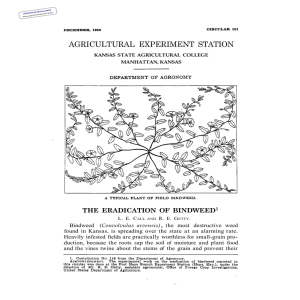PRINCIPAL NOXIOUS WEEDS KANSAS OF of
advertisement
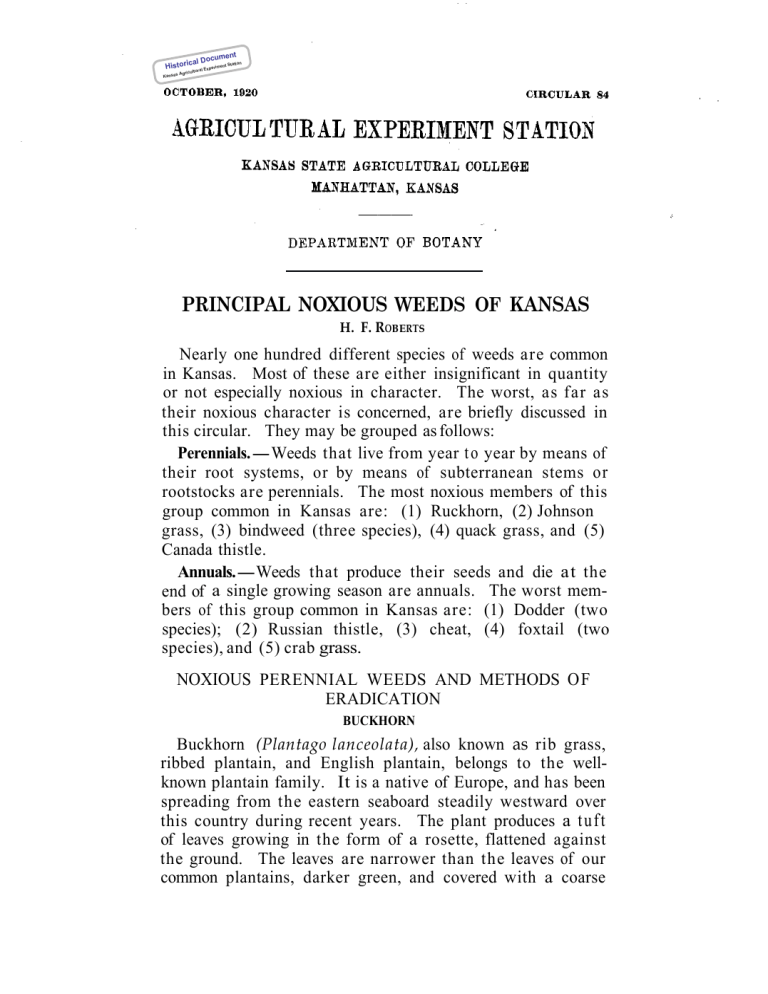
t cumen n cal Do tio Histori ural Experiment Sta Kansas Agricult PRINCIPAL NOXIOUS WEEDS OF KANSAS H. F. ROBERTS Nearly one hundred different species of weeds are common in Kansas. Most of these are either insignificant in quantity or not especially noxious in character. The worst, as far as their noxious character is concerned, are briefly discussed in this circular. They may be grouped as follows: Perennials.-Weeds that live from year t o year by means of their root systems, or by means of subterranean stems or rootstocks are perennials. The most noxious members of this group common in Kansas are: (1) Ruckhorn, (2) Johnson grass, (3) bindweed (three species), (4) quack grass, and (5) Canada thistle. Annuals.-Weeds that produce their seeds and die at the end of a single growing season are annuals. The worst members of this group common in Kansas are: (1) Dodder (two species); (2) Russian thistle, (3) cheat, (4) foxtail (two species), and (5) crab grass. NOXIOUS PERENNIAL WEEDS AND METHODS OF ERADICATION BUCKHORN Buckhorn (Plantago lanceolata), also known as rib grass, ribbed plantain, and English plantain, belongs to the wellknown plantain family. It is a native of Europe, and has been spreading from the eastern seaboard steadily westward over this country during recent years. The plant produces a t u f t of leaves growing in the form of a rosette, flattened against the ground. The leaves are narrower than the leaves of our common plantains, darker green, and covered with a coarse ment cu cal Do Histori ent Experim ultural as Agric Station Kans , woolly coat of hairs on the upper surface. They have ribs or veins which run in raised parallel ridges from base to tip, giving rise to the names rib grass and ribbed plantain. The flower stalk usually grows from 6 inches to 1 foot in height, . rising from the center of the rosette, and bearing at the tip a cylindrical cluster of tiny flowers. (Fig. 1.) The flower head is usually from 0.5 to 1.5 inches long, more or less conical, and bears numerous seed. The seed are small brown objects about the color of flax seed, more or less boat-shaped, with one t cumen on cal Do Histori ural Experiment Stati Kansas Agricult t cumen cal Do ent Station Histori perim l Ex ricultura nsas Ag Ka face hollowed out, bordered by a raised margin, and having a whitish interior. Buckhorn is difficult to eradicate. It is a perennial plant, with a thick taproot, and produces an abundance of offshoots near the crown, which in turn grow to be full-sized seed-bearing plants. Since the plant grows so low it is impossible to mow it, and when once established in a pasture or meadow, the only way to eradicate it is to plow up the land, and to put it, temporarily a t least, into cultivation. JOHNSON GRASS Johnson grass (Sorghum halepense) is a perennial grass, closely related botanically to cane, kafir, and the other cultivated sorghums. It is found distributed widely over the world in warm and temperate climates. Johnson grass, in fact, resembles somewhat the slender stalks of sorghum when the latter is grown thick for hay. It still more closely resembles Sudan grass, which, however, is an annual plant with more slender stalks than those of Johnson grass, and with a fibrous root system instead of thick fleshy rootstocks. The seed head is a loose open panicle or cluster, very similar to that of Sudan grass. (Fig. 2.) t cumen cal Do ent Station Histori perim Ex ultural Agric Kansas The seed is produced abundantly and is tightly inclosed within the chaff, like the seed of sorghum. The seed proper is not visible, but the smooth tight hulls which inclose it are conspicuous when ripe, varying in color from blood-red to dark brown. Johnson grass propagates, not only by seed, but also by means of underground stems or rootstocks. (Fig. 3.) These may easily be mistaken for true roots, but differ from roots in being jointed like stems, and in producing buds at the joints, which are overlapped by leaf-like scales. These buds sometimes develop into other rootstocks, and sometimes, especially when growing near the surface, grow up above the ground and develop into upright stems. In ordinary farming operations, disking and cultivating simply result in spreading the plants, for the reason that a rootstock when cut to pieces will produce a plant from every piece that bears a bud, like the potato, which is propagated by means of the “eyes.” The recent menace of Johnson grass comes from the general introduction of Sudan grass. Much of the Sudan grass seed in the past has come from Texas, where Johnson grass is a prevalent weed. The seed of the two plants can scarcely be distinguished. In bulk, Sudan grass seed is generally yellowish in color, while Johnson grass seed is usually dark red. Sometimes, however, Sudan grass seed is also red. Few seed analysts will undertake t o say that a sample of Sudan grass seed is free from Johnson grass seed. The only safety to the farmer, therefore, in buying Sudan grass seed is t o buy it from a source known to be absolutely safe. In rich bottom-land Johnson grass may send its rootstocks as deep as 4 feet below the surface. Ordinarily, they reach a depth of from 1 to 2 feet. For purposes of eradication, the rootstocks should be compelled to grow as near the surface as possible. This can be accomplished by keeping the plants mowed during the season and by preventing them from producing flower stalks. If allowed to stand, the new rootstocks formed by the crowns of the plants after the flowering period, grow rapidly down into the ground and store up nourishment f o r producing new plants, which sprout from them the following spring, If, however, the plants are kept mowed throughout the season, the crowns will be too weak to produce these new rootstocks in abundance, and the latter will usually not go deeper than from 3 to 6 inches into the ground. By the t cumen cal Do ent Station Histori Kansas perim ural Ex Agricult second season the original rootstocks from which the plants came, will have died out and if the grass is kept mowed again, by late summer the whole mass of shallow-growing rootstocks can be turned out by shallow plowing. Hogs on light feed turned in on this plowed ground, will devour all of the rootstocks and thus eradicate the plants. Instead of mowing, as recommended, the land may be pastured and then plowed. In the following spring, if desired, the land may be put into a cultivated crop and the crop given extra care and attention. All things considered, however, land badly infested with Johnson grass should be mowed o r pastured for two consecutive seasons before plowing. Instead of plowing in late summer, winter plowing, by exposing the rootstocks upon the surface where they are subjected to alternate freezing and thawing, has been found an effective means of eradication. Briefly stated, eradication of Johnson grass requires pasturing o r mowing for a t least a year, followed by shallow plowing in a dry period of late summer or a t the beginning of winter. If it is then possible t o turn hogs upon the land, they will complete the work by rooting through the loose soil and feeding upon the fleshy rootstocks. BINDWEED The three species of bindweed commonly found in Kansas are: (1) Hedge bindweed (Convolvulus sepium) ; (2) trailing bindweed (Convolvulus repens) ; and (3) field or small bindweed (Convolvulus arvensis) . They belong to the morning-glory family. Bindweeds are trailing plants, or twining vines, growing from slender roots o r rootstocks, which, being perennial, produce new shoots continually from buds, which may start from as f a r as two feet below the surface. The underground system of root’s or rootstocks may penetrate the soil to a depth of 6 feet, and even greater depths have been reported. The hedge bindweed and the trailing bindweed, which are natives of this country, have underground stems or rootstocks, from the joints of which buds appear. These may either grow t o the surface and form shoots, or grow horizontally underground into new rootstocks. The small or field bindweed, which has been introduced from Europe, has slender roots instead of rootstocks from which buds may start a t irregular intervals, t cumen cal Do ent Station Histori Kansas perim ural Ex Agricult growing either into other propagating roots or upward to the surface to form shoots. (Fig. 4.) The slender roots, or rootstocks, as the case may be, fill the soil with a dense network of branches, on which innumerable fine fibrous roots grow, and absorb the moisture which should go to the growing crop. In appearance, the leaves of the bindweeds are triangular, spear or arrow-shaped, or even rounded-oblong in shape, according to the species. The flowers are usually white, sometimes pink with white stripes, or pink throughout, and resemble the flowers of the morning-glory. The triangular black seed also resemble morning-glory seed. The hedge bindweed has larger leaves and flowers than the other two species and the hedge bindweed and field bindweed both have smooth leaves, while those of the trailing bindweed are hairy. Of the three species, the one which constitutes a menace t o Kansas agriculture is the field bindweed. Wheat or other small grain sown on land infested with this bindweed becomes overgrown by the trailing and twining vines, which smother out the plants above while depriving their roots of moisture from below. The field bindweed is decidedly the most dangerous t cumen on cal Do Histori ural Experiment Stati Kansas Agricult weed in the state a t the present time. Fields that are heavily set with the weed have practically no agricultural value and the weed where not held under control gradually spreads to surrounding uninfested land. A small patch of bindweed on a farm in central Kansas, where conditions are favorable for its growth and distribution, can if uncontrolled completely overrun the farm in a period of 10 to 20 years. The value of the farm will in that period be reduced from the value of improved agricultural land t o the value of poor grazing land and the farm will become a source of danger t o the entire neighborhood. Great care should be taken, therefore, t o discover small patches of bindweed when they first appear on a farm and no expense o r trouble should be spared to eradicate the weed before it has an opportunity t o spread. (Fig. 5.) In west central Kansas where continuous wheat growing is commonly practiced and where the land generally lies fallow from harvest until late in August, the bindweed when present covers the land with a mat of vines. This dense luxuriant leafage in turn supplies food for the extension of the root system. An advance of 11 feet in a season on the part of the t cumen cal Do ent Station Histori Kansas perim ural Ex Agricult propagating underground root system was observed to have occurred in one. instance. Farm implements carrying the roots also assist in distributing the weed. The persistence of the bindweed was noted in a case in Ellis County where infested land after having been turned back into buffalo grass still contained occasional bindweed plants after 35 years. Land taken by the bindweed plants is soon rendered unfit for wheat. In western Kansas where from 8 t o 15 bushels per acre are produced, the land infested with bindweed will usually produce not more than 2 or 3 bushels per acre and the land sometimes becomes actually unsalable. Various methods for eradicating the bindweeds have been tried. The method of keeping the tops killed down by means of chemical sprays has been thoroughly tested by the Department of Botany of the experiment station and has been found unsuccessful, except through the use of such frequent applications as to make the cost prohibitive. Smothering with mulches of straw, covering with tar paper, sheets of galvanized iron, etc., is possible only in a small way and cannot be applied to the thousands of infested acres in central Kansas. No cropping system will eradicate the bindweed unless cultivation is extremely thorough and persistent. The seed of the bindweed, which, as heretofore stated, are small, black, and triangular (like those of the morning-glory), are usually carried from place to place in seed wheat. All wheat used for seeding should be examined for bindweed seed and should not be sown if these weed seed are present. Wheat screenings may also contain bindweed seed. Wheat screenings or feed containing mixtures of unground wheat screenings should not be fed under conditions where the seed can grow o r where the manure produced from the feed will be scattered on cultivated fields, without first examining the feed to ascertain that bindweed seed are not present. The following methods for the eradication of the bindweed have been followed with greater or less success: APPLICATIONS O F SALT Salt applied in quantities of not less than 10 tons t o the acre will kill the bindweed, though a few individual plants may escape the first application unless the salt is very evenly distributed. These should be destroyed by a second application. t cumen n cal Do tio Histori ural Experiment Sta Kansas Agricult Very little salt, however, will be required the second time. In experiments a t Dodge City, carried on by the Department of Agronomy of the experiment station, where the weed was treated with 5 tons of salt t o the acre, 5 percent of the plants survived; where salt was applied a t the rate of 10 tons t o the acre, only 1 percent of the bindweed plants survived; where 15 tons of salt to the acre were used, the weed was completely eradicated and the roots killed down t o a depth of 18 inches. This indicates that an application of salt a t the rate of about 12 tons to the acre will result in the permanent eradication of the bindweed in one season. The cost of the salt varies according to the locality. The cost from the Hutchinson fields was $4 per ton in 1913, delivered a t Dodge City. While salt is too expensive to use on large areas, it is by f a r the cheapest method of eradicating small patches of bindweed. As soon as a small patch of bindweed appears on the place it should be salted a t once while it can be salted at small cost before a large area of land is infested. Where large areas of bindweed occur it is a good practice t o salt a strip two or three rods wide around the outer edge of the patch. This will prevent its spreading. The area on which the bindweed is growing should then be cultivated by itself and all possible precautions taken t o keep the weed confined within the salted area. Ground upon which salt has been applied in any large quantities will remain unproductive for many years, especially in the drier sections of the state, but i t is better to have an unproductive spot in a field caused by salt, than t o have a patch of bindweed which constantly spreads to surrounding areas of land and thus endangers the productiveness of the entire farm. CROPPING It is impossible t o eradicate bindweed by any cropping system. Certain cropping systems are better than others in holding it in subjection. In central and western Kansas continuous deep fall or early winter plowing, followed by seeding to sowed sorghums, will cheek the spread of the weed and gradually reduce the stand of the plants, but as f a r as is known, this method has never completely eradicated them. In eastern Kansas alfalfa sown in the fall on ground that has been thoroughly cultivated throughout the summer and the bindweed held under control for this fallow period, will start and with t cumen n cal Do tio Histori ural Experiment Sta Kansas Agricult ...- favorable conditions make a stand. If once established alfalfa will hold the bindweed under subjection and may in time completely eradicate it, although this is not definitely known. This, however, is the best method of handling bindweed infested fields in the eastern part of the state. CLEAN CULTlVATION By clean cultivation is meant keeping the land fallow and keeping the bindweed plants continuously cut off below the surface so that they will not be able to form leaves above the ground. If this method is rigidly pursued the bindweed can finally be eradicated by this means. At least three years of continuous clean cultivation is required. This is not practical and would be almost impossible to carry out on a large area of land. Under field conditions bindweed is easily spread by cultivation machinery. The roots of the weed may cling to plows, harrows, or cultivators running through bindweed patches, and in this way be carried to other parts of the field where they may fall and grow. In this way the weed is spread. It is always the best practice in working fields containing bindweed patches, to work the patches by themselves and to see that no roots are carried by machinery to parts of the farm uninfested by the weed. TURNING ON H O G S AND FALLOWING By confining hogs on a small area of land covered with bindweed i t may be possible in time to eradicate the weed. The hogs will have to be closely confined to the bindweed area. Deep plowing will throw out the roots and make it easier for the hogs to get at them. The roots have a flavor resembling that of sweet potatoes and are relished by hogs. Q UA C K GRASS Quack grass (Agropyron repens) is a native of Europe. In this country it has gradually spread westward from the Atlantic seaboard, reaching Kansas some years ago, and being recently reported in some localities in northeastern Kansas as having become a serious pest. Quack grass (fig. 6) has long been recognized wherever it has appeared as a noxious and pestiferous weed, extremely difficult to control. Until recently, a t least, i t has been regarded as almost impossible to eradicate. t cumen on cal Do Histori ural Experiment Stati Kansas Agricult Quack grass forms a dense tight sod by means of the vast tangled growth of the rootstocks, and should be resolutely eradicated wherever it occurs. Two methods of eradication have been developed, which may be called the Vermont methodl and the Minnesota method,² respectively. The Iatter, being simpler, is recommended f o r pasture land that has become infested. The ground is plowed 7 or 8 inches deep while the grass is in bloom from the middle of June t o the middle of July, using a chain on the plow and otherwise taking care to cover all the plants. The ground is then double-disked immediately lengthwise of the furrows, lapping the disk one-half, but setting the disk shallow and taking care not t o turn up the sod. The disking is repeated every three or four days f o r four or five weeks, and then once a week for the rest of the season, t cumen cal Do ent Station Histori Kansas perim ural Ex Agricult o r often enough t o keep the quack grass below the ground. The next year clean cultivation is maintained with corn planted in checkrows. Small tufts of quack grass around posts should be dug out by hand, and small patches can be covered with tar paper, lapped and held down with stones. In two months or so the grass will be dead. In many cases quack grass has become established through the use of impure seed of Hungarian brome grass. Since January 1, 1905, 92 samples of this grass have been examined in the station’s seed laboratory. Forty-five of them contained the seeds of quack grass. Most of these, probably all, came originally from the northern part of the United States. Quack grass must be watched for and eradicated as soon as discovered. It has become a dangerous pest in Minnesota; in Vermont it is regarded as one of the worst, if not the worst weed in the state. Those interested in special features of the Vermont method will find the details in the Vermont bulletin heretofore referred to. Special tillage is the basis of the method, but the system is rather elaborate. The Minnesota method is the one most likely to appeal to Kansas farmers, although the underlying principles of the two methods are the same. It should be stated that there is no method o f getting rid o f quack grass in pastures or hay meadows, short o f plowing and disking the land. CANADA THISTLE The true thistles all belong to the family of plants to which the sunflowers and goldenrods belong. Most of the thistles are biennials (plants whose natural life is two growing seasons) and can be eradicated by mowing and burning before they go to seed. The Canada thistle (Cirsium arvense) (fig. 7), however, is a perennial, growing from creeping rootstocks which send up numerous shoots to the surface. The Canada thistle is not yet a t all common in this state, and if proper precautions are taken, need never gain a foothold. Like many other extremely troublesome weeds, it is a native of Europe. The leaves are finely divided, very prickly a t the edges, often somewhat woolly underneath and green on both sides. The flower and seed heads are numerous and much smaller than those of the ordinary pasture thistles. Farmers can easily distinguish this weed from the other thistles by digging it up. If only a single taproot is found, the plant is not Canada thistle. If t cumen on cal Do Histori ural Experiment Stati Kansas Agricult long creeping horizontal underground stems are found, there can be no doubt about the identity of the plant, as Canada thistle is the only member of the thistle family in o u r territory which has this habit of growth. Eradication is best effected by cutting the Canada thistle when in full bloom in July, and raking up and burning the plant. The ground should then be plowed shallow and Hungarian millet sown a t the rate of 1 bushel per acre. This should be plowed under in September and the land seeded to winter rye. About the middle of May the rye should be plowed under. By the middle of June, the ground should be again plowed and by the middle of July or earlier again seeded to millet t o be cut for hay in the fall. By following this method the Illinois Agricultural Experiment Station succeeded in completely eradicating the Canada thistle which was growing t cumen cal Do ent Station Histori Kansas perim ural Ex Agricult thickly on 2.5 acres of prairie loam. Here, as in the case of bindweed and quack grass, the secret of success lies in preventing any top growth o f the plant whatever. NOXIOUS ANNUAL WEEDS AND METHODS OF ERADICATION DODDER The dodder plant (fig. 8) is a yellow, or orange-colored leafless vine that twines around various kinds of succulent plants, sending into their tissues numerous suckers that absorb their juices. Such plants are called parasites, the plants upon which they feed being called the host plants. When a dodder seed germinates its seedling has a t first a small slender root, but as soon as the stem finds a host plant upon which it can grow, the root dies and the dodder henceforth derives its food en- t cumen n cal Do tio Histori ural Experiment Sta Kansas Agricult tirely from the host. Later in the season, the dodder vine produces flowers in dense whitish clusters, and finally an abundance of seed. Ofttimes the dodder vines grow in dense yellow masses, forming patches several yards square. Although very destructive to the plants upon which they feed, because of their parasitic habits, the dodder plants are nevertheless easily kept under control. If a patch of field infested with dodder is mowed before the dodder plants have gone to seed, and is then burned, there will be no danger of dodder on the same spot the following season. There is always a possibility, of course, that some seed may have ripened and fallen from the vines, if the flowers were in full bloom when the plants were mowed. A patch infested with dodder should t cumen n cal Do tio Histori ural Experiment Sta Kansas Agricult therefore be watched the succeeding season for any surviving plants. There are two kinds of dodder that are noxious weeds in this state, both of which should be watched for and guarded against, in our clover and alfalfa fields. The first is the field dodder (Cuscuta arvensis). The vines of this species are pale yellow in color, while the clover and alfalfa dodder (Cuscuta epithymum) has red stems. Of the two species the field dodder is by f a r the more common, the seed of the other species occurring very much more rarely in clover and alfalfa seed. Dodder seed are small, roundish, yellowish-brown in color, and, under a lens, show a multitude of rough points or dots on the seed-coat. (Fig. 9.) Because of their color they often escape notice in the seed of alfalfa and red clover. They can be distinguished from alfalfa and clover seed, however, by their form and size. RUSSIAN THISTLE Russian thistle (Salsola Kali var. tenuifolia) is not one of the true thistles, and does not belong to the thistle family, but to the goosefoot family (Chenopodiaceæ)—to which the pigweeds, giant tumble-weed, and the salt-bushes belong. The plant is a much-branching annual, at the ends of the short triangular leaves of which prickles develop. Frost kills the plants to the ground and when dry they are broken off and rolled over the ground in great numbers by the winds, thereby scattering their seed. The Russian thistle is chiefly found in the western portion of the state, where is has become a nuisance. Being an annual plant it can be killed out by clean cultivation, summer fallowing, and by growing smother crops. Mowing and burning hedge fences, corners, and waste lands generally, especially in the fall when the dried weeds blow out, will prevent the propagation of the Russian thistle, since i t is propagated only by the seed. Where land is farmed continuously in wheat, and lies bare from harvest until fall and where crop rotation and the growing of cultivated crops is little practiced, the Russian thistle will remain a pest and cannot be gotten rid of. Restrictive measures such as mowing and burning will assist in keeping the weed in subjection, but eradication is impossible without cultivation and rotation of crops. In the eastern part of the state, where more atten- t cumen on cal Do Histori ural Experiment Stati Kansas Agricult .. tion is given t o crop rotations, and where more intensive farming prevails, the Russian thistle will never become a serious pest. CHEAT Cheat, or chess (Bromus secalinus) , likewise a weed introduced from Europe, is one of the brome grasses. The most important of the brome grasses is Bromus inermis, which has been grown as a pasture and hay grass in Kansas for many t cumen on cal Do Histori ural Experiment Stati Kansas Agricult years. Cheat, unlike Bromus inermis, is an annual grass and its seed are chiefly introduced and distributed in the seed of English bluegrass which they somewhat resemble, although larger than the latter and bearded. The cheat plant itself is a grass with few leaves and tall nodding heads or panicles, which are loose and open like a head of oats. ( F i g . 10.) The seed are borne in meshes or spikelets, carried at the ends of numerous slender branches which hang down from the main branches of the flower head. There has been a very common superstition to the effect that wheat and other plants turn to cheat. This, of course, is impossible. Cheat is a plant of itself, and cheat plants come from cheat seed and from nothing else. There is no especial difficulty in getting rid of cheat, if care is taken t o plant clean seed, especially of English bluegrass or meadow fescue. FOXTAIL There are two species of foxtail common in our area: Green foxtail, (Chaetochloa viridis) and yellow foxtail (Chaetochloa glauca). The former is usually the more common of the two. The foxtails are too well known to need description. Clean cultivation will eradicate them. CRAB GRASS Crab grass (Digitaria sanguinalis) is a native of the United States, and is a much more troublesome weed than the foxtails because of its habit of throwing out long prostrate stems which root at every joint and send up flowerstalks which bear numerous seed. When ground becomes foul with weeds like crab grass and foxtail, the only remedy is clean cultivation for a few seasons, or until all the weed seed have been sprouted and killed.
